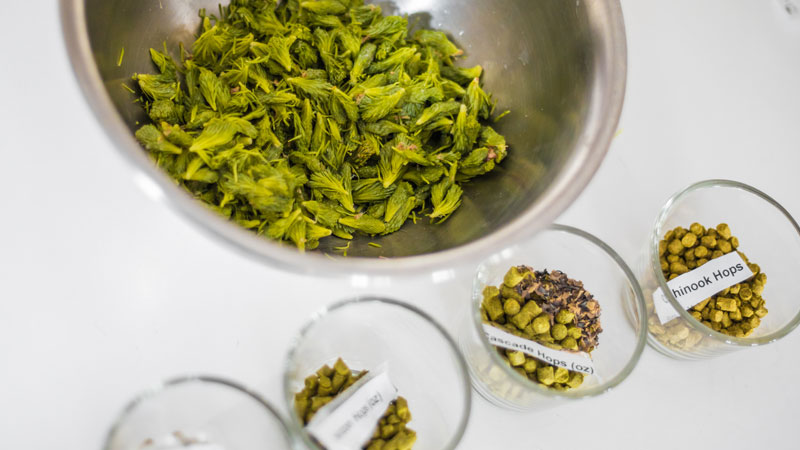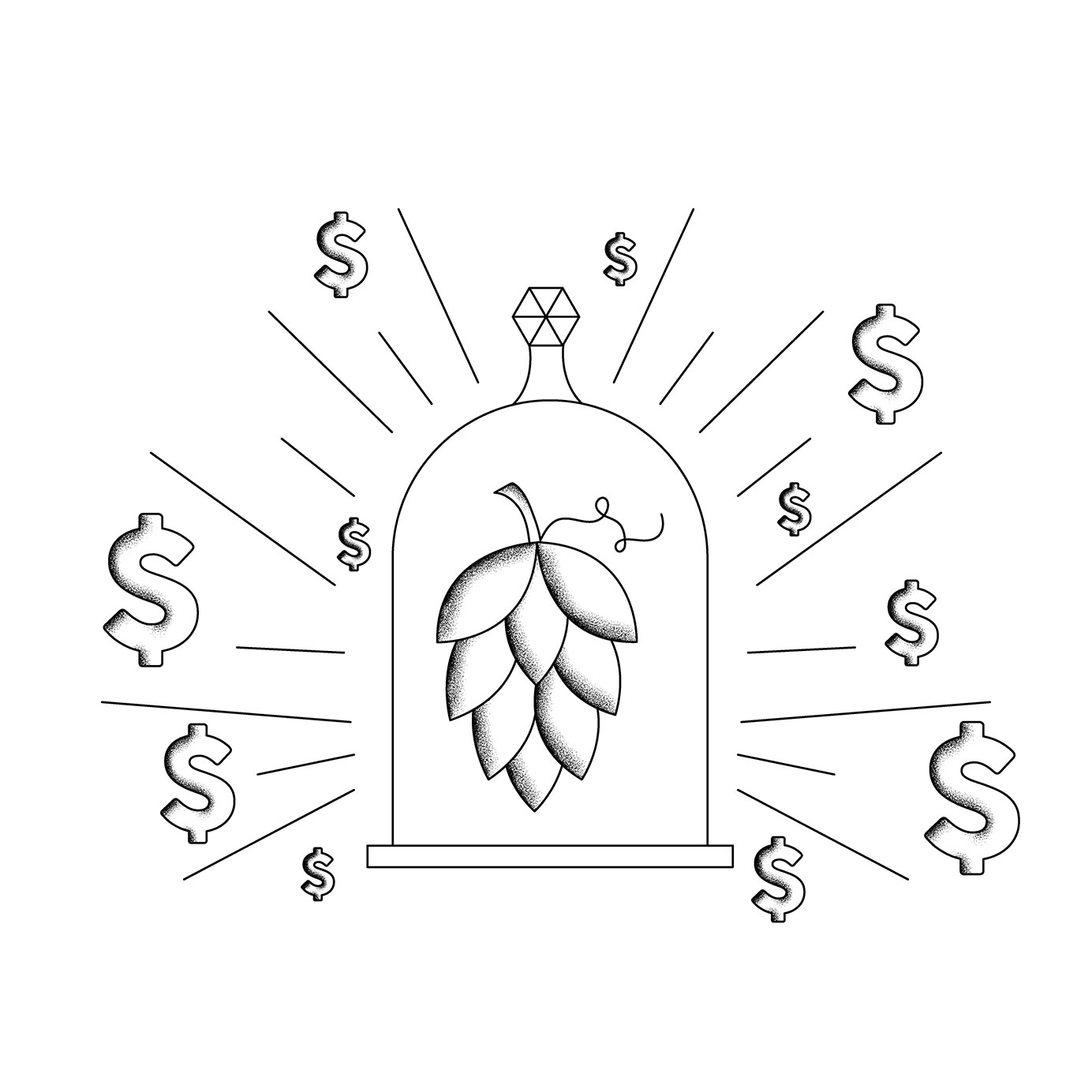After “juicy,” the word most often associated with New England IPAs is “crushable.” Yet 4-packs of 16-ounce cans run for more than $20 at some craft breweries. That’s a lot to spend on an ephemeral crush.
The same factors that make New England IPAs (NEIPAs) popular also contribute to their higher price points. Their hazy appearance and pillowy, creamy mouthfeel are the result of expensive raw materials and processes, as are those bright, juicy notes of tropical fruits like melon, pineapple, and mango.
This particular combination of hops, malt, and yeast, coupled with their short shelf life, make NEIPAs one of the more expensive beers to produce. How, then, are national breweries like New Belgium able to sell their NEIPAs for merely $11.99, a figure comparable to 6-packs of Corona?
We crunched the numbers with five brewers. The results are pretty, well, crushing.
Raw Goods
The leading factor in NEIPAs’ higher price point is the hops. Not only are brewers often using double the amount of hops found in American IPAs, they’re also using higher-priced varietals to deliver the juicy pops of tropical fruit that define the style, and distinguish it from its West Coast brethren.
Weedy Weidenthal, brewmaster at Tombstone Brewing Company in Tombstone, Ariz., says that he uses six pounds of hops per barrel in his NEIPAs. That’s roughly double the amount of hops in a West Coast IPA. And so 4-packs of 16-ounce cans of Tombstone’s NEIPA sell for $10 in the brewery and $13 at retail — $2 to $5 more per beer than most of the label’s other offerings.
On a 20-barrel system, at a price of $15 per pound, the cost of raw goods jumps from $900 to $1,800. And that’s if the brewery is using more common hops like Amarillo, Citra, Simcoe, and Mosaic. “If you’re getting into Galaxy and Nelson Sauvin hops, then the price can jump to $20 or $30 per pound,” Weidenthal says.
Those are the exact types of hops that Great Notion Brewing prefers. The Portland, Ore., brewery has racked up a trophy case of awards for its NEIPAs, Juice Jr. and Ripe.
“They go so well in a hazy IPA, giving out beautiful melon and guava notes,” Paul Reiter, Great Notion’s co-founder, says. “It’s what we love to drink so we brew with it.” Four-packs of 16-ounce cans of Great Notion’s Juice Jr. cost $18 at the brewery.
Using additional hops lowers yields as a larger amount of wort is absorbed into the hops, resulting in more unusable sludge and less beer output. Thus, there is less product to sell to offset the higher cost of hops.

The second-largest cost driver is the yeast. Brewers use an atypical strain in NEIPAs to create the appearance, flavor, and mouthfeel of the style. They opt for a lower-attenuating, lower-flocculating, and ester-forward strain of yeast that adds body, keeps hop oils in suspension, and delivers its own fruit notes.
The cost of the yeast itself is comparable to other strains, but it is a single-use strain, whereas other styles can be used for up to 10 generations.
The reasons are twofold. First, the yeast is a top-cropping strain. Unlike most yeasts, which settle to the bottom of the fermenter and can easily be harvested for future use, the NEIPA yeast strain settles at the top of the fermenter. Fermenters have closed tops, so brewers can’t reach in to harvest the yeast.
Second, even if brewers could harvest the yeast, they wouldn’t want to. In NEIPA production, a majority of the hopping occurs during dry hopping, and the yeast would pull too much flavor from the hops.
Hence, the $700 cost for a 4-liter pitch of yeast is only spread across one 20-barrel batch of beer instead of multiple 20-barrel batches.
Some breweries can save money by propagating (growing) their own yeast. Unfortunately, propagators run around $8,000. Neil Gimon of DreamChaser Brewery, whose NEIPA won a gold medal in the 2017 U.S. Open Beer Championship, says that cost isn’t affordable for a brewery his size.
The malt bill for NEIPAs provides some financial reprieve. It is different from that of classic IPAs, but in the specialty grains only. While traditional IPAs use crystal malts, brewers have to purchase high-protein flaked oats or wheat — malts they might not have on hand — to create more haze. However, the purchases are minimal as speciality malts only make up roughly 10 percent of the overall malt bill.
Shelf Life
The short shelf life of a NEIPA is more of a driver of soft cost, in terms of brand reputation, than pricey front-end investment. If you buy a 4-pack of hazy IPA only to get home and discover that the beer has lost its haze, then there’s a chance you won’t buy that beer again. This is a real risk for breweries, as all haze does eventually disappear.
“A lot of these beers have a significant yeast load,” Fred Rizzo, director of brewing operations at Avery Brewing, says. Avery will be releasing its first attempt at the style, Hazyish IPA, later this year. “That yeast will eventually die, which creates an off flavor.”
Another risk is oxidation. With each transfer the beer makes between tanks and to final bottling, the beer is introduced to oxygen. “When you smell hops coming off during transfer, you’re losing aroma,” Weidenthal says.
Economies of Scale
So how are big craft breweries making affordable NEIPAs, and across a larger distribution footprint? The answer is, of course, buying power and access to better equipment.
Smaller breweries have to go through brokers to acquire their hops, whereas those brewing over 25,000 barrels a year can buy direct, often halving prices. The same goes for purchasing grains. Smaller breweries tend to buy by the bag at $.71 per pound, versus by the silo at $.59 per pound.
Bigger breweries can also distribute nationwide without worrying about the style’s finicky nature because they have access to centrifuges, which help reduce the yeast load. Their canning systems also reduce dissolved oxygen levels more than the mobile or less expensive systems used by many small breweries.
Personal Finance
“As a consumer, I’ve paid $25 for a 4-pack and thought it was totally worth it,” Ross Koenigs, research and development brewer at New Belgium Brewing, says. “If you see it’s a value to you, go for it.”
Any well-made, small-batch product, be it craft coffee or beer or a pair of designer sneakers, will cost more than its equivalent made en masse.
Of course, it’s not always possible for everyone to spend freely. Many brewers take this to heart.
“Our retailers tell us to bump up our prices, but we believe in reasonable and responsible pricing,” Weidenthal says. “I don’t like the idea of pricing out the average American.”
